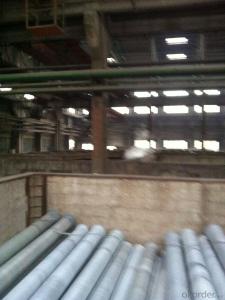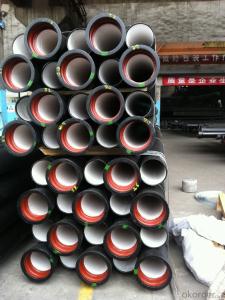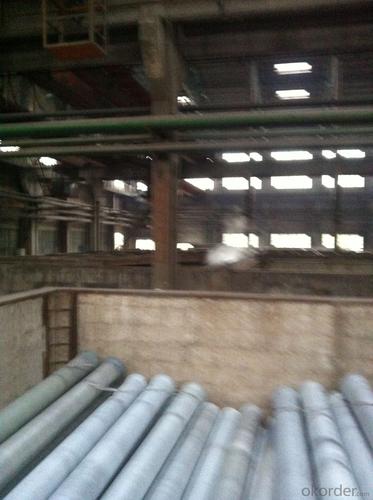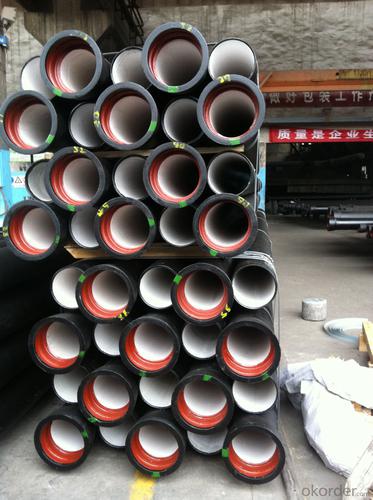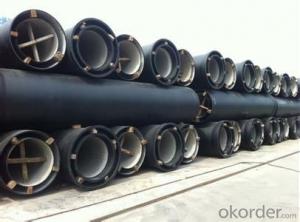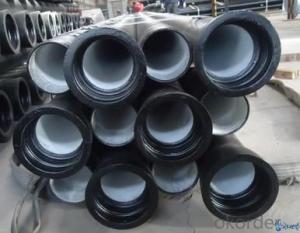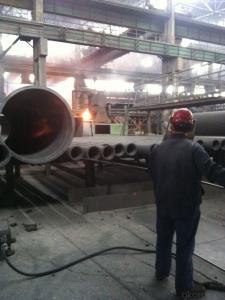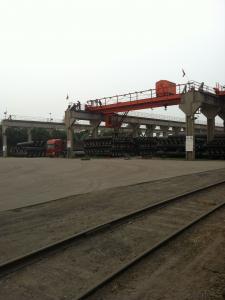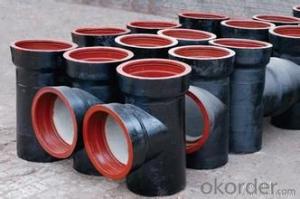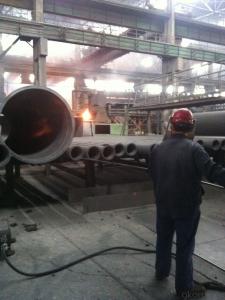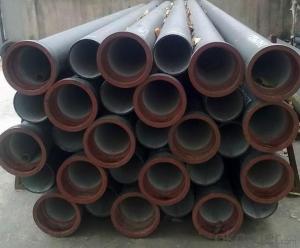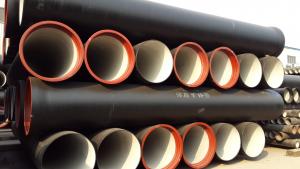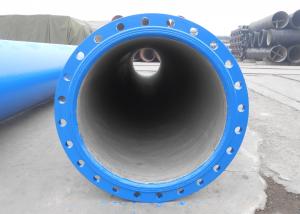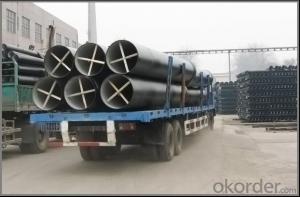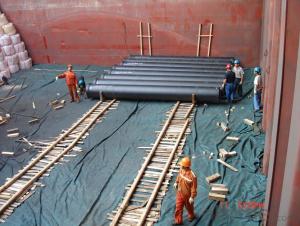DUCTILE IRON PIPES & FITTINGS K9 CLASS DN100
- Loading Port:
- Tianjin
- Payment Terms:
- TT OR LC
- Min Order Qty:
- 20 pc
- Supply Capability:
- 3000 pc/month
OKorder Service Pledge
OKorder Financial Service
You Might Also Like
Specifications
· Material : Ductile Cast Iron
· Size Range : DN 80mm to DN 2000mm
· Unit Effective Length : 6m or 5.7m
· Manufacture Standard: ISO 2531:1998/ EN 545:2006/EN 598:2007
· Annual capacity : 200,000 tons
· Coating Exterior: Zinc 130g/m2 according to ISO 8179-1 and bitumen coating 70 microns.
· Cement Interior: Portland Cement/ High Alumina Cement/ Sulphate Resisting Cement Lining according to ISO 4179
· Special requirements on external coating and internal lining can be applied
· We also provide accessories such as SBR/EPDM rubber gaskets, lubricant paste, pipe caps, PE sleeves, etc.
Additional Parts:
Each pipe is strictly inspected according to related standard to ensure permanently high performance.
Easy Installation at site and service free for life
Long Service Lifespan
Quotation will arrive you within 24hours once we get your inquiry.
We guarantee offering you a competitive price.
A copy of original inspection reports of pipes will be offered after shipment.
Photos of loading process will be sent to the customer after shipment effect.
We will follow-up the delivery progress after shipment effect and update to the customer on weekly basis.
- Q: What are the different types of coatings available for ductile iron pipe?
- Ductile iron pipe offers a range of coating options, each with its own unique properties and benefits. 1. One commonly used coating is cement mortar. It involves applying a layer of cement mortar to both the interior and exterior surfaces of the pipe. This coating protects against corrosion and abrasion, while also improving hydraulic efficiency. 2. Another popular choice is polyethylene encasement. This involves wrapping the pipe with a layer of polyethylene material. It provides excellent corrosion resistance, especially against soil and water contaminants. 3. Fusion-bonded epoxy (FBE) coating is applied by heating epoxy powder to create a strong bond with the pipe surface. It offers outstanding corrosion resistance and is commonly used in aggressive environments like wastewater treatment plants and chemical processing facilities. 4. Zinc coating, also known as galvanization, is applied by adding a layer of zinc to the pipe's surface. It provides excellent corrosion resistance and is often used in outdoor applications exposed to moisture and humidity. 5. Bituminous coating is a black, tar-like substance that protects against corrosion. It is commonly used in underground applications where the pipe is in contact with soil or water. 6. Polyurethane coatings are known for their resistance to abrasion, impact, and chemical corrosion. They are often used in aggressive environments such as oil and gas pipelines. These examples highlight the different coatings available for ductile iron pipe. The choice of coating depends on factors like the intended application, environmental conditions, and desired level of corrosion protection. It is crucial to consult industry experts and follow relevant standards and specifications when selecting a coating for ductile iron pipe.
- Q: Are ductile iron pipes suitable for use in cold climates?
- Ductile iron pipes are well-suited for cold climates due to their exceptional strength and durability. This makes them a reliable choice for various applications, such as water supply systems, sewage systems, and industrial piping. In freezing temperatures, ductile iron pipes are highly resistant to cracking or breaking. This is because of their unique metallurgical composition and structure. They possess a high tensile strength and can endure the expansion and contraction resulting from freezing and thawing cycles. Additionally, their smooth internal surface prevents ice or sediment buildup, ensuring efficient flow and reducing the risk of blockages. Overall, ductile iron pipes are a dependable and appropriate option for use in cold climates.
- Q: Steel plastic pipe, ductile iron pipe, steel pipe difference
- Spheroidal graphite tube, now application has been relatively small, generally used for conveying water, gas at room temperature, low pressure, large diameter pipelines need to produce concrete pipe base, good corrosion resistance than steel pipe joints, vulnerable to external extrusion and leakage, the price is relatively cheap.
- Q: Can ductile iron pipes be used for hydropower projects?
- Yes, ductile iron pipes can be used for hydropower projects. Ductile iron is known for its strength, durability, and resistance to corrosion, which makes it suitable for various applications including hydropower projects. These pipes can effectively handle the high pressure and flow required for hydropower generation, making them a reliable choice for this purpose.
- Q: Can ductile iron pipes be used for drainage systems in airports?
- Yes, ductile iron pipes can be used for drainage systems in airports. Ductile iron pipes are known for their durability, strength, and resistance to corrosion, making them suitable for various applications, including drainage systems. They are capable of withstanding heavy loads, which is important in airports due to the constant movement of aircraft and vehicles. Ductile iron pipes are also flexible, allowing for easy installation and modification when necessary. Additionally, they have a long lifespan, reducing the need for frequent maintenance or replacement. Therefore, ductile iron pipes can be a reliable choice for drainage systems in airports, ensuring efficient water flow and preventing water accumulation, which is crucial for maintaining safe and operational airport facilities.
- Q: Are ductile iron pipes resistant to chemicals?
- Yes, ductile iron pipes are highly resistant to a wide range of chemicals, making them suitable for various applications involving corrosive substances.
- Q: What is the relationship between the direction of the spigot and the direction of the flow in the ductile iron pipe?
- Called "ductile" (Ductile Cast Iron Pipes), referred to as ball pipe, ductile iron pipe and ductile iron pipe etc..
- Q: Are ductile iron pipes suitable for gravity flow applications?
- Ductile iron pipes are indeed suitable for gravity flow applications. This material, known for its strength and durability, can easily bear the weight of water and solid waste flowing through the pipes without encountering any problems. It possesses exceptional tensile strength and can withstand external forces like soil movement or heavy traffic loads without sustaining damage. Moreover, the inner surfaces of these pipes are smooth, ensuring efficient flow and minimal friction losses. Additionally, ductile iron pipes are resistant to corrosion and can last for several decades without necessitating frequent maintenance or replacement. In conclusion, ductile iron pipes are a dependable option for gravity flow applications due to their robustness, longevity, and ability to resist various environmental factors.
- Q: Are ductile iron pipes suitable for underground installations?
- Yes, ductile iron pipes are suitable for underground installations. Ductile iron is known for its strength, durability, and resistance to corrosion, making it a reliable choice for underground applications where the pipes may be subjected to various environmental conditions. Additionally, ductile iron pipes have the flexibility to withstand ground movement and can be easily installed using various trenchless methods, making them a preferred option for underground installations.
- Q: Will the quality of ductile iron shrink?
- Fool you. It is normal that the surface shrinks and goes down, but it can not be said to be good.
Send your message to us
DUCTILE IRON PIPES & FITTINGS K9 CLASS DN100
- Loading Port:
- Tianjin
- Payment Terms:
- TT OR LC
- Min Order Qty:
- 20 pc
- Supply Capability:
- 3000 pc/month
OKorder Service Pledge
OKorder Financial Service
Similar products
Hot products
Hot Searches
Related keywords
